How to Design A Sale Email With Dynamic Product Feed
Nowadays, dynamic content is one of the most effective tools an email marketer can use.
By having dynamic content in emails, you can:
-
Deliver real-time content and keep our recipients updated. You can use it in email newsletters to send the freshest blog posts, or in promo emails to notify recipients about how soon the offer expires, or let users book appointments, etc.;
-
Personalize products to make emails even more relevant. You can use it in promo emails to create offers based on individual preferences, previous purchases, geolocation, gender, etc., or in abandoned carts, order confirmation emails, etc.
It is impossible to turn email marketing into a profitable channel without using dynamic content. Email marketers must find smart ways to manage product data in their messages, adding purchasing opportunities to email campaigns without wasting any resources.
In fact, 69% of consumers are more likely to buy from companies that use personalization techniques, according to Campaign Monitor.
So what types of dynamic email content can you use and how to implement them in your future email campaigns? That is what I’m going to discuss in this article, introducing you to the powerful dynamic product feed of AVADA Email Marketing. With this, you will be able to make your marketing automation even more personalized and sales-focused.
Let’s get started!
Why should your email have a dynamic product feed?
Nearly every eCommerce retailer and business already uses a product data feed on a regular basis. The most popular usage of it is to help marketers advertise products on Google, Facebook, or Amazon. However, it can do much more as well. It can even help marketers create stronger email nurturing campaigns by showing product data right inside emails.
Instead of sending the same types of products to every subscriber or hand-drafting emails for each segmented group, email automation paired with data feeds makes the process of personalizing email campaigns simplified at a new level. That means products can be dynamically displayed to nurturing messages as desired. Plus, data-driven marketing automation doesn’t just exist as a practical time saver, it can also drive better results.
When MailChimp tried testing their customized recommendations tool, thousands of emails were sent to thousands of users. Interestingly, the results indicated that hand-crafted messaging’s result is second to smart and product-oriented email marketing automation. Customers love to see the products that are curated for them.
In short, emails with dynamic product recommendations make more money.
Who should use dynamic product feed in emails?
Product data isn’t just a tool for online retailers. Of course, consumers seeking shirts, games, and house products are obvious candidates to use smart product recommendations, but any business that sends out “products” in email messages can benefit from this. Recruiters, realtors, travel agencies - these all can use a dynamic product data feed to make their emails smarter and more automated.
No matter what you are advertising or selling, marketing automation and a dynamic product feed can increase sales and make email marketing easier. Now, let’s see how you can get started and add a dynamic product into your email.
How to design a sale email with dynamic product feed

There are many ways a dynamic product feed can appear in an email campaign.
When an eCommerce business sends out a newsletter of their latest products, the product feed can be used to dynamically show products most likely to spark interest from a particular group of recipients. An advertiser can send an abandoned cart email including products similar to those that were already in the cart. A job agency can even use product feed to automatically display new job listings for a particular geography location.
However, simply adding a dynamic product feed to your email campaign won’t ensure clicks at scale. The key will be adding dynamic products that actually fit the user’s profile. This requires a strong data feed as well as the right marketing tool.
The tool that you will use in this article is none other than AVADA Email Marketing - our eCommerce dedicated app that helps create automated email sequences and send personalized messages to customers. The app has all an online business needs to get started, including:
-
Strong audience segmentation and analytics to support realistic product matching.
-
A fantastic email marketing automation tool to pull together subscriber data, product data, and easy email delivery for accessible analytics.
-
Product recommendation generation features to properly pair products with customer profiles.
-
A spotless and optimized dynamic product feed to ensure the delivered products are irresistible.
In this article, I will talk about two key places that you should add a dynamic product feed in your emails, using AVADA Email Marketing. Let’s see where they are:
1. Add a dynamic product feed into behavior-triggered emails
These are important moments where a customer or prospect is most engaged and very likely to open your email. Because they have more intention to open and click, it’s crucial for you to place unique offers or product recommendations inside these emails.
Common behavior-triggered emails that should have a dynamic product feed are:
-
Abandoned shopping cart emails: The user has eyes on a product or two (or more), selected to add them to their cart, and then, boom. The user stalls at checkout. There are many reasons for this: the user may be comparing the product against similar ones found elsewhere or still be considering the purchase. Now is the perfect time to create abandoned cart reminder emails, just in case the user were on the fence and needed a little push.
-
Order confirmations and update emails: Every customer wants to know if their purchase is on the way or not. That’s why we almost always open order confirmation emails of any kind. Because the buyers are actively looking for confirmation, keep this email simple and send some uniquely relevant products rather than having an overwhelming list of all your promotions. For example, you can send a “complete the look” email with related products. Now that the customer has made a purchase, and their buying intention is still warm, remind them about any products that may go along well with their purchase.
-
Welcome emails: Get subscribers acquainted with your offers from the beginning by sharing most popular products or those uniquely relevant to their data or profile. It is also a great opportunity for time-sensitive incentives and promotions.
-
Birthday emails: Everyone likes a special offer, and, because customers expect a special offer in the birthday messages, they’ll be likely to open emails sent just for their special day. It is the perfect opportunity to stroke their ego and give them the deal they want to give themselves something special.
-
Milestone emails: Has any user been your customer for a whole year or more? Did someone just make their tenth purchase? Commemorating milestones in the user-brand relationship can help make users feel more inclined to keep in touch and purchase more. Milestones are also a great opportunity to let customers know that, after so many months together, your company can pinpoint some awesome deals that the customers are going to love.
Let’s see these emails in action with a dynamic product feed. I will take you through the actual steps that AVADA Email Marketing users use.
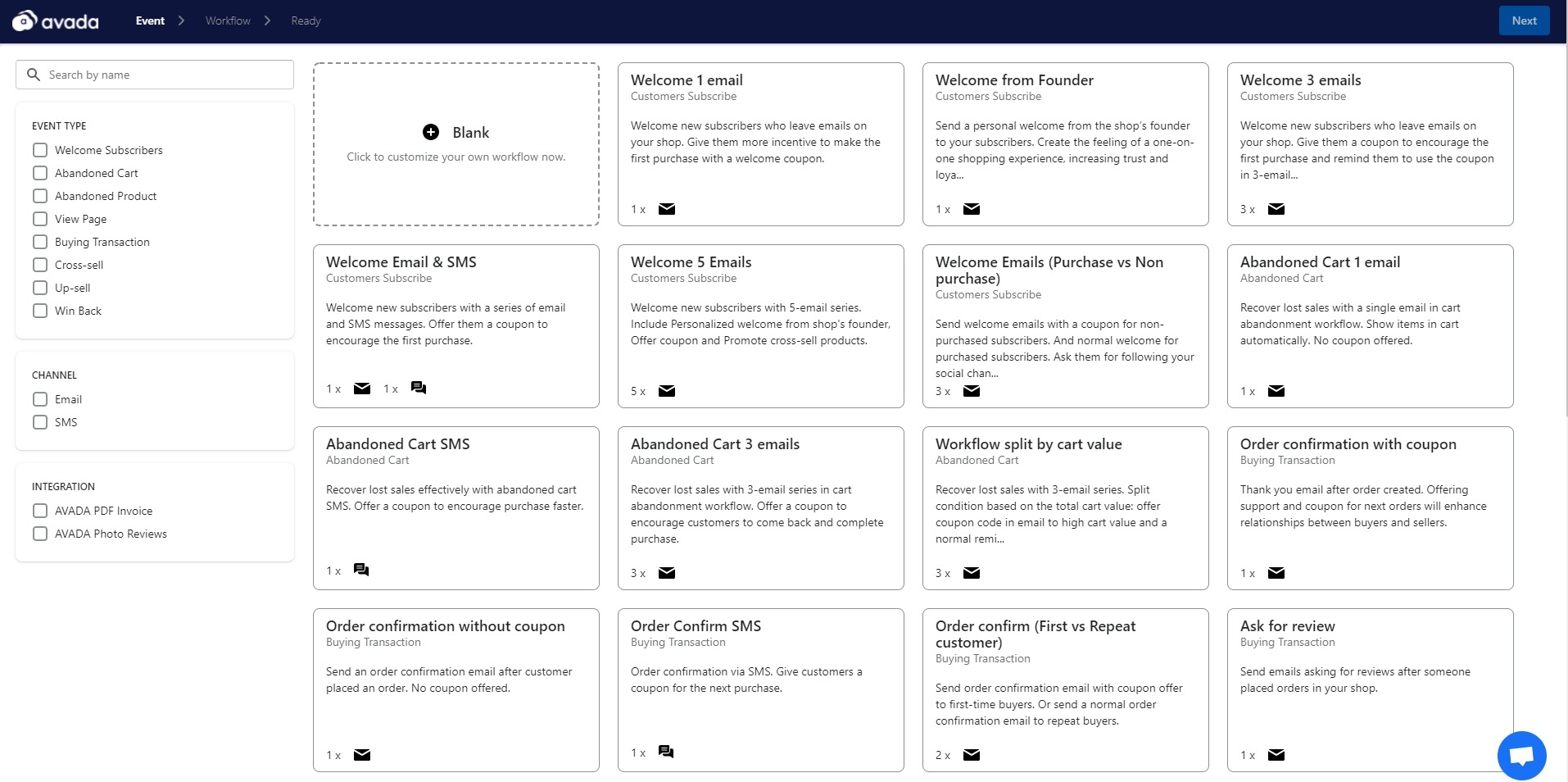
First, you need to select an automated event for your email campaign. Inside AVADA Email Marketing, users will find multiple automated triggers, which can send one email or more (as an email sequence) to subscribers based on their actions. As you can see in the screenshot, there are event triggers for welcome, abandoned cart, order confirmation, and more.
Click to choose an event you like, and you will get access to the email editor. For this article, let’s try abandoned cart email.
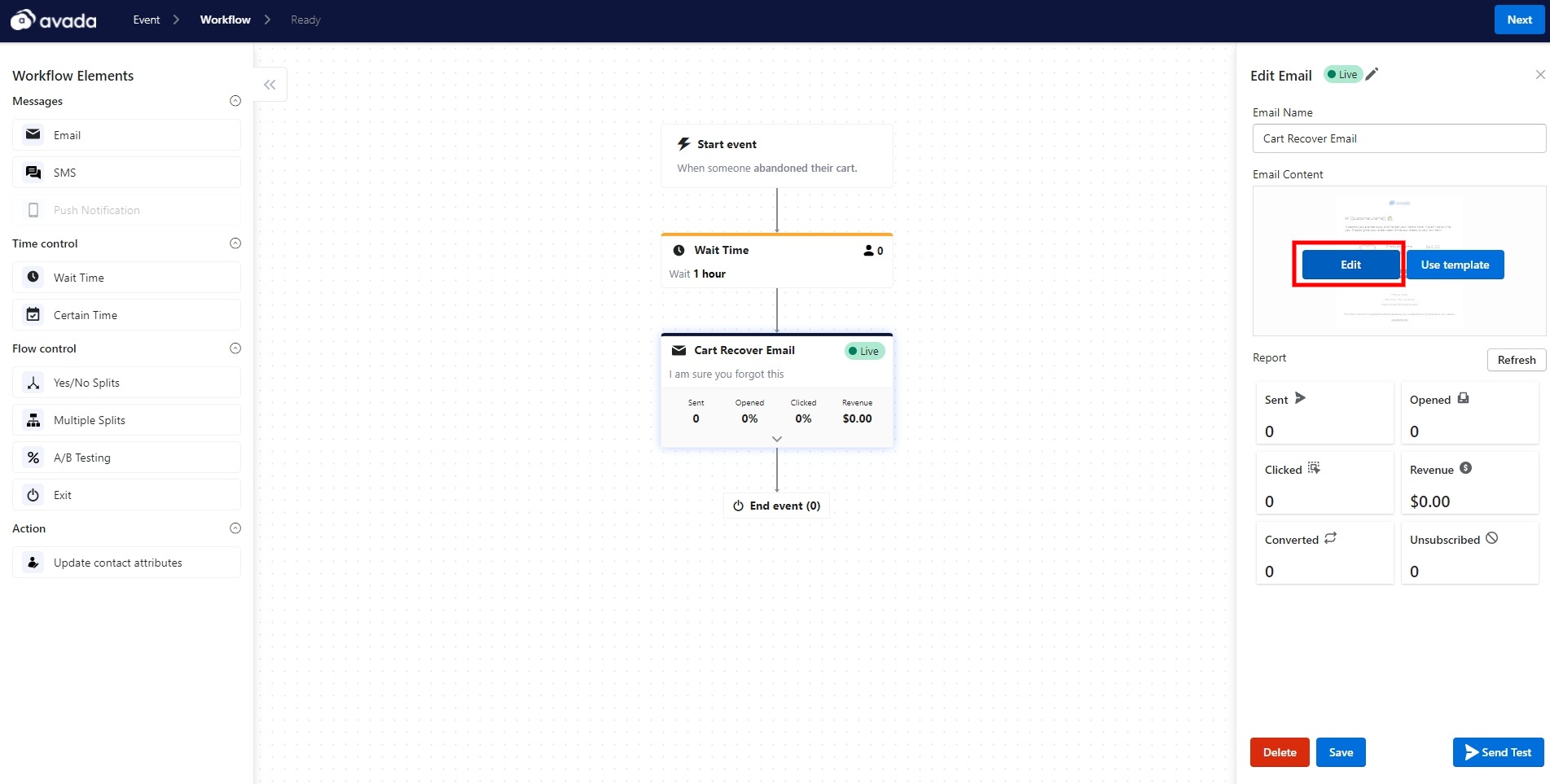
In the second phase, called the “Workflow” step, users can see the full overview of the email sequence. There are the start of the event, which are the trigger, the wait time, and the email itself. You can customize the workflow so your email would act the way you want. I set it by default, since one hour wait time for an abandoned cart email is pretty reasonable already.
Next, let’s see the abandoned cart email and its dynamic product feed. Click on the Cart Recovery Email and click Edit to continue.
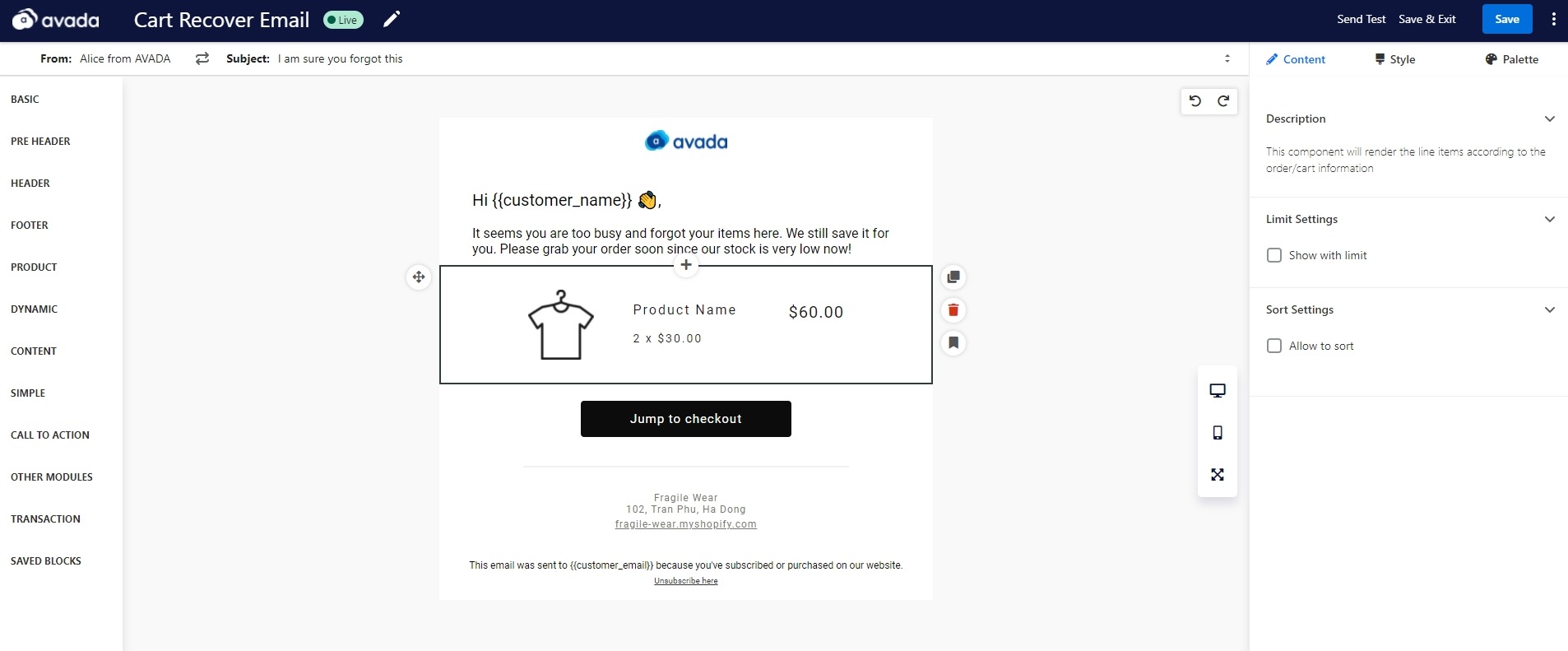
Inside the email editor, you will find the email template for the cart abandonment email. It includes a copy to notify buyers about their abandoned cart, a dynamic product feed that shows products in their cart, and a call to action button with the copy of “Jump to check out” - which will take them to the checkout page of the cart.
The dynamic product feed here is used to show the products that users already have inside the cart and will update for each buyer. Your buyers can then view the product name, pricing, and total price to check out. On the right panel, you can control the limit settings and the sort settings of the dynamic product feed.
You can also change the style of the dynamic product feed inside the editor, changing its typography, background color, and text color. The component of the dynamic product feed will automatically render according to the order/cart information, so you can use it in other types of emails as well.
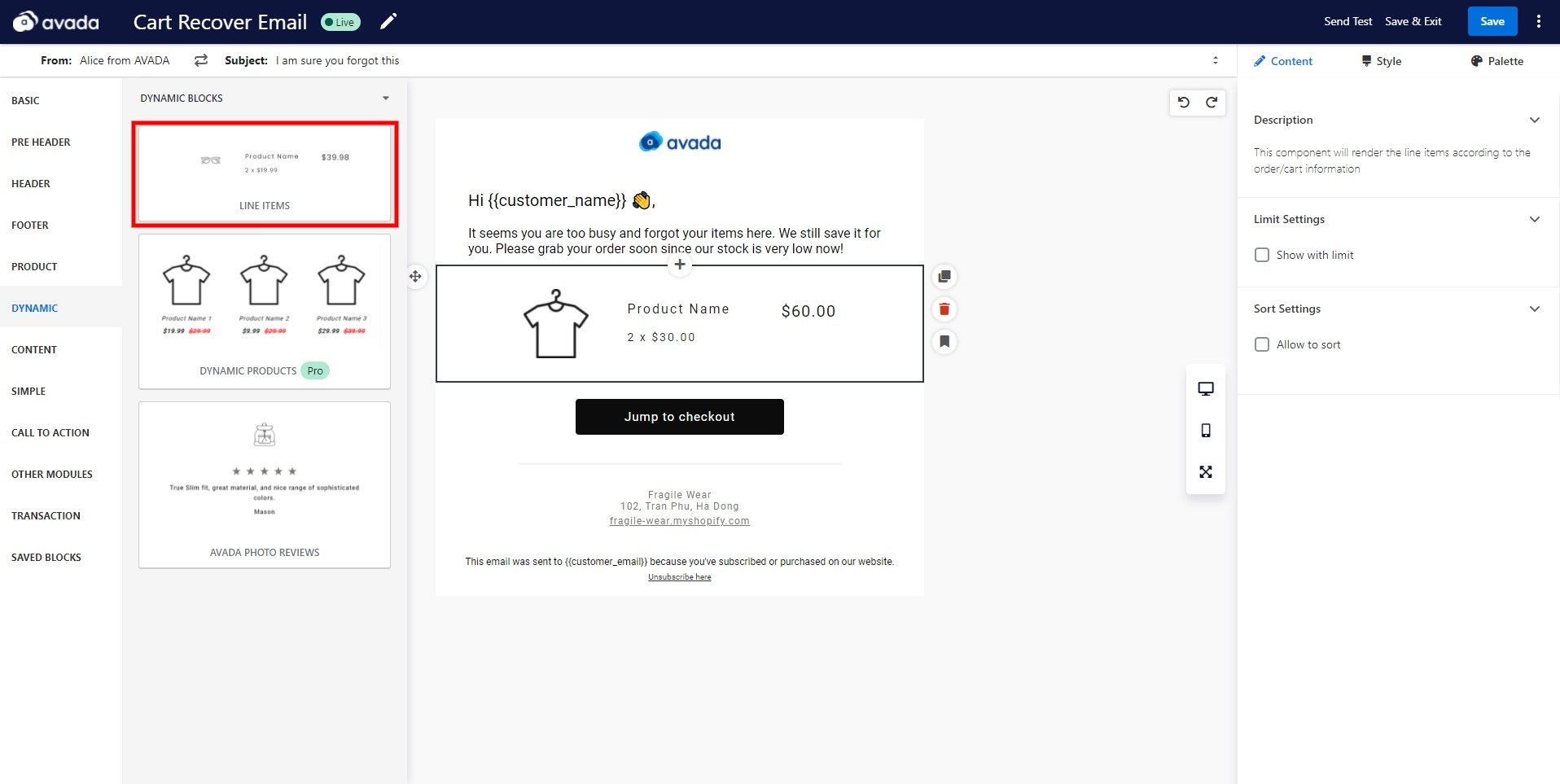
To access the dynamic product feed such as this one, simply click on the left panel at “Dynamic” and you will find it to drag into the email. As you can see, there is another dynamic product feed waiting for us to use right under it. Let’s see it in action as well.
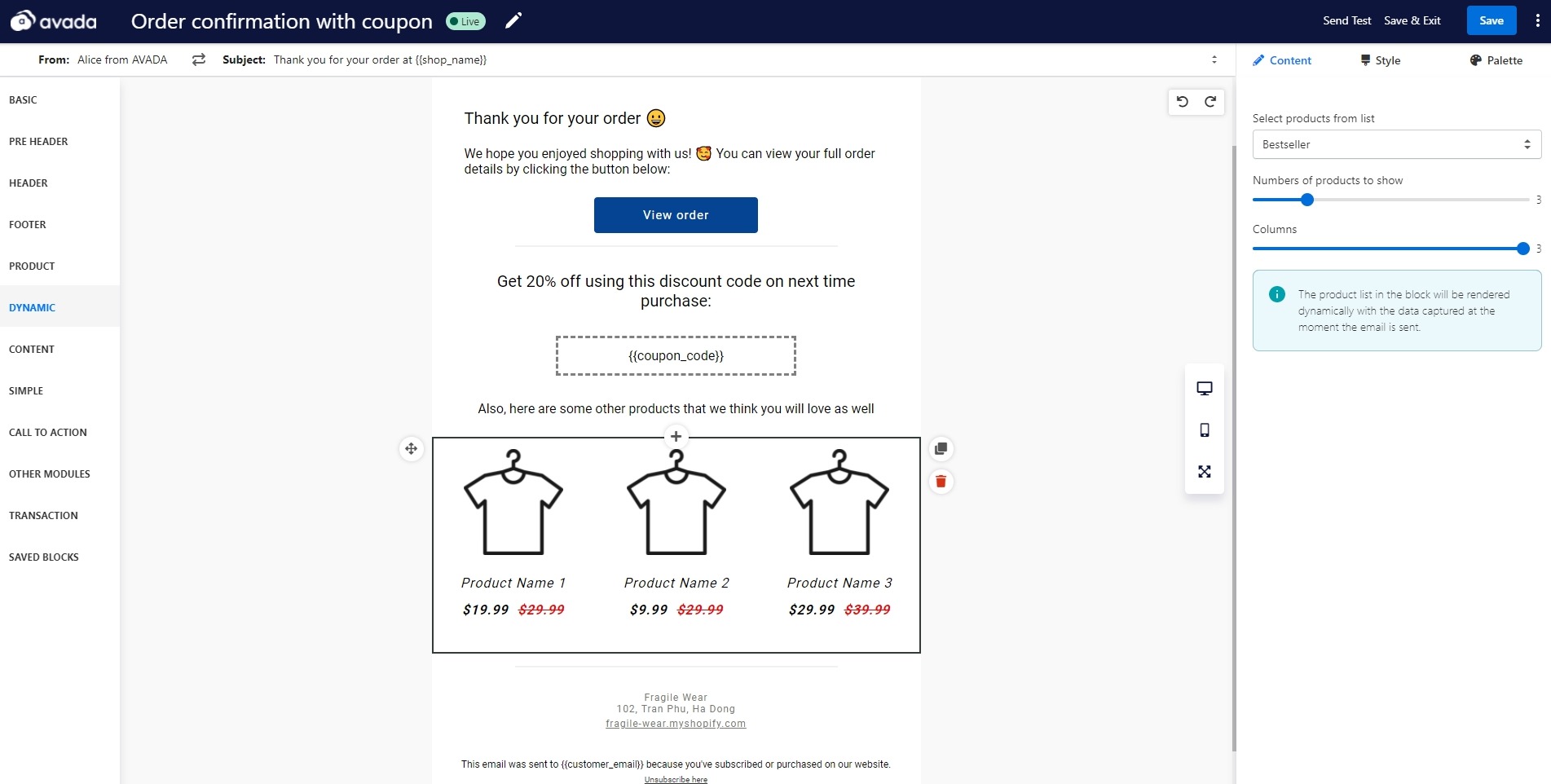
Here, inside an order confirmation email, you can see the dynamic product feed in action. This is a pro feature, so you will need to upgrade to the Pro version of AVADA Email Marketing to use it.
The idea of this order confirmation email is pretty simple. The customer opens this email to view their order to find that we have sent them a coupon code to get 20% off the next purchase. In order to make them check out new products and consider using the coupon right away, we include a dynamic product feed inside the email.
You can select the list of products to show in the feed, the number of products to show, and the column to customize the product feed. Three items is a good number here, since the customer is still warm but may only be willing to check out only one or two items.
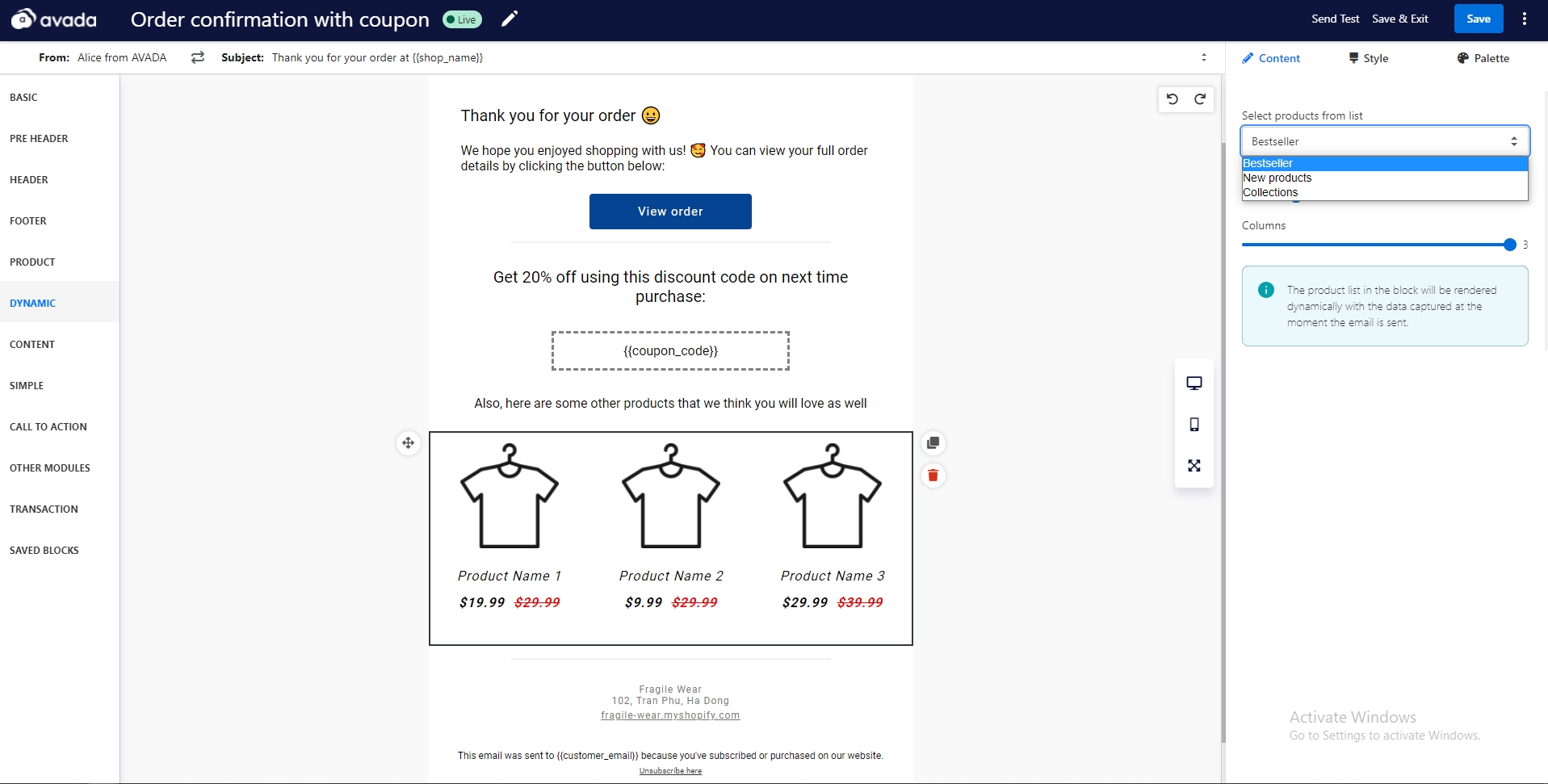
To select the type of products to show inside the dynamic feed, simply click on the dropdown selection in the right panel and choose. There are options for Bestseller, New products, and Collections. For the Collections option, you can create a collection of products beforehand, such as products from homepage or products for summer. This will allow you to control what types of products you want to personalize for your customers.
With the right products showing up in the feed, this can very well be the tool you need to earn the next sales.
2. Add a dynamic product feed into general nurturing email campaign
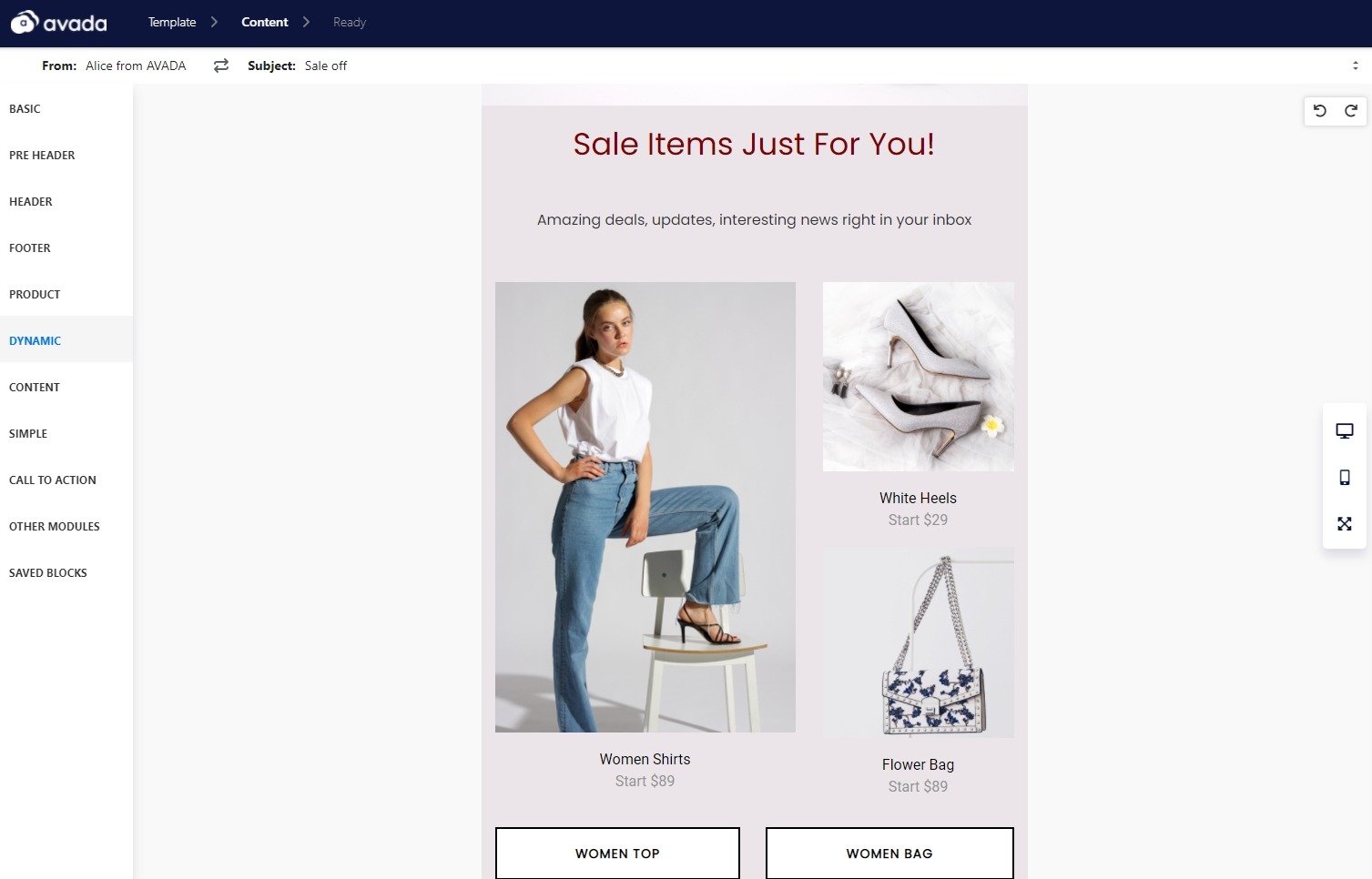
Blog followers, newsletter subscribers, and individuals in email campaigns have shown clear interest in your product and service, now it’s just time to convert them into a particular sale by using email marketing.
Users receiving emails about hiking products probably want to know more about specific items that are suitable for their interest, for example. Subscribers to a trendy fashion shop or even a travel company’s newsletter are looking to learn more about the relevant topics, such as trips and locations.
In short, there’s no reason that modern marketers should not leverage product feeds and automated recommendations in their email campaigns.
However, when adding a dynamic product feed to nurturing email campaigns, be careful not to let the feed take over the email. Subscribers users have signed up for a blog newsletter, the primary goal should still be delivering a good newsletter, only using products to highlight your content.
If you haven’t tried this method already, try adding some product recommendations with a dynamic product feed to your next campaigns using these words as CTAs:
-
“Complementary products”
-
“Complete the look”
-
“Most popular”
-
“On sale”
-
“Recently viewed”
The same process applies here, you just need to drag the dynamic product feed into the newsletter to make it appear to recipients. With a bit of color and design, your nurturing email campaign can look magnificent as the one above. The dynamic product feed will also update its color based on the design of your email, blending in perfectly with other elements.
Best practices for adding a dynamic product feed into emails
Once you’ve got products dynamically appearted in your email campaigns, it’s time to start optimizing to have the best results. There are a few best practices and tips to always keep in mind when adding a dynamic product field into your emails.
-
Keep it short. Your “Top recommendations” shouldn’t have 50 products, no one would look through all of them. Huge selections only imply that the brand doesn’t really understand the customers, and it won’t generate click through. A buyer will want to view only the most relevant products to them, so try to put your best foot forward.
-
Don’t settle for just one type of suggestion or product. Some users often respond to “similar products” feed. Some others love “most popular” collections. Others may enjoy a curated list of your best seller products. If an email is going to include dynamic product listings, don’t use just one type. Try including a few different product suggestions so users have plenty to choose from ( but not being overwhelmed).
-
Mix it up. Don’t show the same product feed email after email. The fun of the “dynamic” part is that you can match users with different lists depending on where buyers fall in the funnel. A buyer in the top of the funnel may not be so ready for a big purchase, and those who have been shopping for a while may have memorized the “most popular” product list and just wait for a small sale off.
-
Don’t give it all away. Customers should be left feeling curious, so don’t give them all the information right up front. In order to turn a case of “those products look nice” into a click, you should retain an amount of information from the product feed. Whether it’s the final price or specs, give the customers an incentive to click through rather than just look. Even if that click doesn’t lead to a buy, you still gain another data point to help in the future.
Final words
A sale email with a dynamic product feed is the best friend of an email marketer. You can personalize the recommendation to send offers based on the relevance of each individual buyer. That is a gigantic power on the conversion rate and the overall ROI of your email marketing effort.
You can build a sales email with a dynamic product feed in under ten minutes using AVADA Email Marketing. If that sounds like a dream come true, then try out the app today. It is free to start using, just click on the link below!
New Posts

How To Set Up Google Analytics 4 For Your BigCommerce Store






